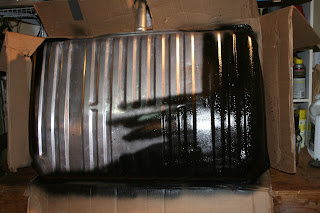So, out came the old axle, after taking off the rear bumper that's dented and will be replace and after taking out the gas tank which was rusted and needed replaced.
I opened up the new axle and inspected the gears. There was little to no sign of wear and when I pulled the brake drums off I found a new brake job so, I'm fairly confident in the quality and since I only paid $300, I think I got a steal.
Here you can see the old "One Tire Fryer" axle on top and the limited slip axle on bottom. I don't know what the Posi axle was in most recently but, the numbers on it say that it came out of a late 60's Grand Prix. It kind of makes me feel like singing that old Sesame Street song, One of these things is not like the other. The most obvious difference is that the previous installation used leaf springs and there are no coil spring brackets on the Posi unit. There's also a missing rubber bumper. The other difference isn't so apparent. Look at the shock absorber mounting bolts.
The difference is a little clearer here. Apparently the prior owner, didn't have any bolts so the solution was to weld two 3/4 sockets over the holes. I pulled the rubber out of the old shock and the steel ring fit over the socket...barely.
Needless to say, they had to come off. I wonder how much damage the shocks did to the body without the little bit of side to side play the rubber gives them.
So, with the sockets cut off, the rubber bumper pad installed and the coil mounts cut from the old axle and welded to the new axle precisely where they had been in the old application, it's ready to go in.
No time like the present to pull the old drive line out and replace the U-Joints.
I wonder how much a pile of 45 year old U-Joints would go for on eBay? I replaced both joints with some heavy duty Moog joints. I'm pretty sure the ones that came out were installed at the factory. They were pretty harsh.
I was washing the new tank with degreaser to prep for paint and heard a rattling in the tank. The float had come off the sending unit that had been installed prior to shipping. I'm glad I found it now. If it had come off a little later, I would have been chasing electrical for weeks and still not solved the mystery. After fishing it out and securing it, I painted the tank with a rubberized coating.
Before I installed the tank I put some air to the fuel line and blew out a cup or two of old gas. Then, I rigged my air nozzle with the straw from a can of brake cleaner along side it and blew an entire can of brake cleaner through the line up to where it will connect to the fuel pump and then more air to dry it out. After that, a new set of straps tied the tank to the frame and I sat her back on the ground for the first time in a few months. I'm not putting any effort into the undercarriage at this point. My goal is to get her looking good and on the road. After that, I can use the hoist at my son's place of employment to more easily strip and coat the undercarriage.


















































